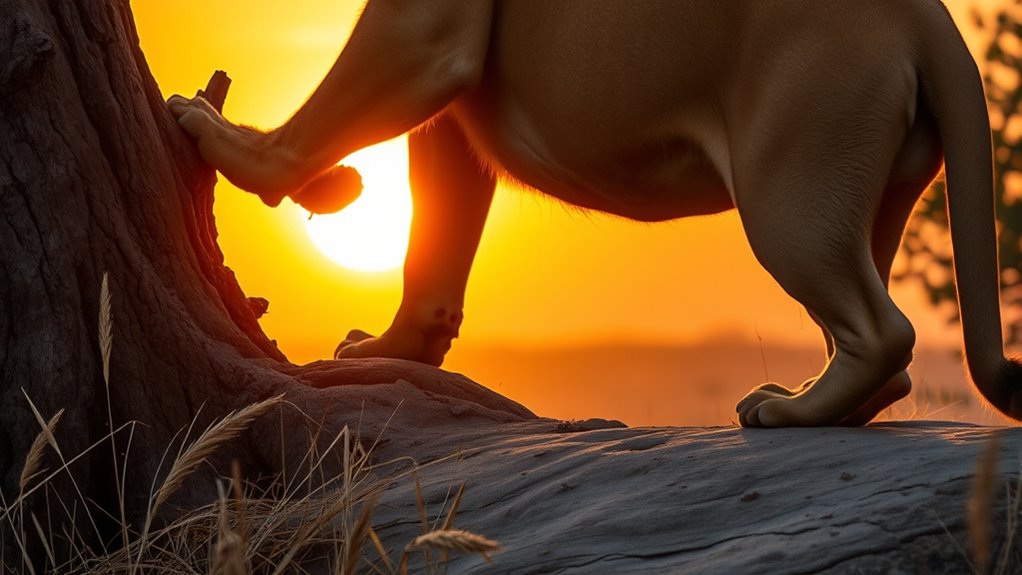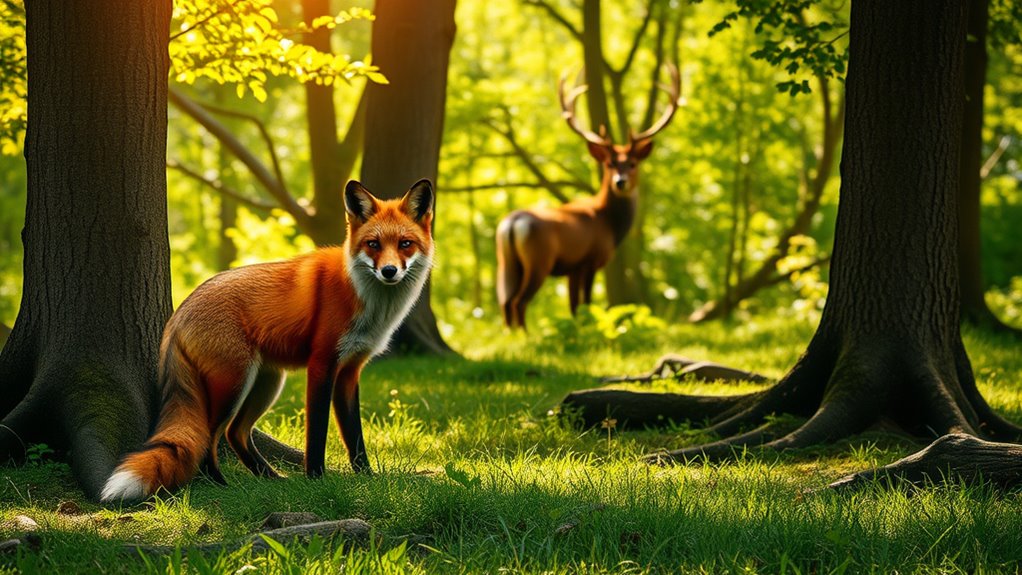Animals mark their territory using various techniques to secure essential resources and ward off competition. They employ scent marking, visual cues, and vocalizations. Scent markings, like urine or gland secretions, communicate their presence. Visual signals, such as bright colors or altered environments, serve as warning signs. Loud calls and howls can announce territory over long distances. By understanding these methods, you can appreciate the complex ways animals maintain their domains. There's much more to discover about territorial behaviors!
Key Takeaways
- Animals use scent marking from glands and feces to communicate their presence and establish territory boundaries.
- Visual cues, such as bright colors or alterations in the environment, serve to signal territorial claims to others.
- Auditory signals like howling or calls announce territory presence over long distances, deterring potential intruders.
- Ritualized aggression displays, including body language and vocalizations, intimidate intruders without physical confrontation.
- Increased marking behaviors often occur during breeding seasons to reinforce territorial claims and attract mates.
Function of Territoriality

Territoriality serves an important role in the survival and reproductive success of many animal species, as it directly impacts their access to essential resources.
For instance, black bears defend their territories to secure important food sources, nesting sites, and mating areas from competitors. By marking and protecting their territory, black bears guarantee they've uninterrupted access to resources, which enhances their chances of survival and successful reproduction.
Black bears defend their territories to ensure access to vital resources, boosting their survival and reproductive success.
This behavior is particularly important as resource availability can vary seasonally, making territorial defense critical during pivotal periods.
While only a minority of species, like black bears, exhibit strong territoriality, these actions considerably improve their individual fitness by reducing competition and increasing the likelihood of attracting mates.
Types and Size of Territories

When you look at animal territories, you'll notice they come in various types and sizes, each tailored to specific needs.
For example, some birds establish all-purpose territories while others focus on mating or wintering grounds.
The size of these territories can range dramatically, influenced by the species and the resources available in their environment.
Types of Animal Territories
Animals establish various types of territories to fulfill specific needs, and these territories can vary considerably in size and function.
Here are some common types of animal territories:
- All-Purpose Territories (Type A): Used for various activities, including feeding and nesting.
- Mating Territories (Type B): Focused on attracting mates, often excluding foraging.
- Foraging Territories: Set aside primarily for hunting or gathering food, crucial for survival.
- Social Territories: Established by groups like spotted hyenas, these areas are essential for social interactions and resource sharing.
Each type serves specific functions during different life stages, influenced by factors like purpose, season, and resource availability.
Understanding these types helps you appreciate the complexity of animal behavior and their strategies for survival.
Territory Size Variation
Understanding how territory size varies among species reveals much about their behavioral ecology and resource needs. For instance, bird territories can be categorized into six types, such as all-purpose or mating territories, each serving distinct functions.
Species like squirrels might claim territories up to 10 hectares, while European badgers can range from 30 to 300 hectares. In contrast, spotted hyenas boast territories that can span from under 4,000 hectares to over 100,000 hectares, showcasing their complex social structures.
Factors like seasonal changes, resource availability, and geographic features influence territory size. Some species, like European robins, defend their territories as pairs during breeding but switch to individual defense when resources dwindle in winter.
Understanding these variations helps clarify animal behavior.
Retaining a Territory

To retain a territory, animals use sign-posting techniques like scent marks and visual cues that clearly communicate their presence.
When intruders approach, you'll often see displays of ritualized aggression meant to intimidate without engaging in costly fights.
Different species adopt unique strategies for defending their space, influenced by available resources and social dynamics.
Sign-Posting Techniques
While many creatures instinctively defend their territory, they also employ various sign-posting techniques to communicate their presence and status. These methods effectively advertise their occupation and can reveal information about their sex and dominance.
Here are some common techniques:
- Scent marking: Animals use anogenital glands to mark surfaces, with some, like wombats, even using cubical feces that won't roll away.
- Visual marking: Creatures may display vivid colors or alter their environment, such as male European robins showcasing their bright red breasts.
- Auditory marking: Howling wolves send territorial signals that can be heard from great distances, signaling their presence.
- Strategic placement: Markings are often found along boundaries or scattered throughout their territory to maximize visibility.
These techniques help maintain their territory without physical confrontations.
Ritualized Aggression Displays
Ritualized aggression displays play an important role in how animals defend their territories without resorting to physical confrontations. These behaviors, like vocalizations, body posturing, wing spreading, and claw presentation, signal dominance and deter intruders.
For instance, when domestic cats encounter rivals, they often use posturing to convey their intentions, avoiding direct conflict. The displays can vary in intensity, ranging from subtle warning signals to overt threats, reflecting the perceived threat level from an intruder.
Territory Defense Strategies
When animals establish a territory, they engage in a series of strategic behaviors designed to defend their space and resources effectively.
This defense often involves a three-stage process, including:
- Creating sign-posts: Animals mark boundaries with visible signs to announce their territory.
- Scent marking: Species like the Eastern carpenter bee and wombats use scents and feces to communicate occupancy.
- Ritualized aggression: They display intimidating behaviors, such as vocalizations and posturing, to deter potential intruders without physical conflict.
- Resource-based adjustments: Some animals only defend their territory during peak resource times, like birds during breeding seasons.
Advertising the Territory

Animals have developed a variety of methods to advertise their territory, ensuring that potential intruders are aware of their presence.
Scent marking is key; for instance, eastern carpenter bee females secrete substances from their anogenital glands, while wombats use cubical feces to mark their areas.
Visual markers also play a role; male European robins flaunt their red breasts, and dominant white rhino bulls create dung heaps.
Auditory signals are equally important, with wolves howling to announce their territory, producing sounds that can travel over 130 km.
During the breeding season, many mammals ramp up scent marking to reinforce their claims.
These methods help establish boundaries without resorting to aggression, making territory advertisement essential for survival.
Ritualized Aggression

While some encounters can escalate into physical confrontations, many species rely on ritualized aggression to assert their territory. This approach minimizes injury risks and conserves energy, allowing animals to maintain their claims without engaging in fights.
Many species use ritualized aggression to establish territory, reducing injury risks while conserving energy.
You might notice this behavior in various species, including domestic cats and European robins, which display aggression through:
- Vocalizations that communicate dominance
- Body language, like puffing up or arching backs
- Graded displays that escalate with perceived threats
- Intimidating postures that deter intruders
These displays create a clear message: you're not welcome here.
Defense Strategies

Territorial defense strategies come in various forms, each tailored to the needs of the species and the specific environment they inhabit.
You might notice animals employing ritualized aggression—like vocalizations and wing spreading—to intimidate intruders while avoiding physical confrontations. This approach saves energy and reduces injury risk.
For instance, European robins defend their territories in pairs during breeding season but shift to individual defense in winter. The hawk-dove game model illustrates the different aggression strategies at play, while the war of attrition model emphasizes persistence in these contests.
Many animals also use powerful auditory signals, such as wolf howls, to announce their territory from great distances, allowing them to establish dominance without engaging in direct confrontations.
Resources Defended

Defending territory goes hand in hand with the resources within it. Animals choose their territories based on the quality and distribution of essential resources.
Here's what they typically defend:
- Food sources: Large carnivores need vast areas to secure enough prey, while smaller species focus on local food availability.
- Mates: Male butterflies and striped mice aggressively protect their territories to attract receptive females, which boosts their mating success.
- Nesting sites: Ground-nesting birds fiercely guard their breeding areas to protect nests and chicks, creating hexagonal spacing through competition.
- Specific materials: Creatures like gardening limpets and penguins defend resources like algae or nesting materials, ensuring their reproductive success and survival.
Polyterritoriality

Many animals adapt their territorial strategies to maximize access to resources, leading to a fascinating behavior known as polyterritoriality. This involves maintaining multiple territories simultaneously, which helps guarantee access to diverse resources or mates.
For instance, the European robin defends a breeding territory while also holding onto a winter territory, adjusting its defense based on seasonal availability.
Red foxes exhibit similar behavior by claiming overlapping territories for hunting and breeding, allowing them to exploit various resources.
Male butterflies also defend multiple territories rich in floral resources to attract females.
Polyterritoriality showcases the dynamic nature of territoriality, demonstrating how animals adjust their claims based on competition, resource distribution, and environmental changes to enhance their fitness.
Frequently Asked Questions
How Do Animals Mark Each Other?
When animals mark each other, they often use a mix of scents, sounds, and visual displays. You might notice them rubbing against each other or using specific pheromones to communicate their presence and establish connections.
Vocalizations, like howling or growling, can signal territory or dominance. Additionally, certain species might engage in posturing or ritualistic behaviors, showcasing their strength or intentions without physical confrontation, ensuring boundaries are clear without escalating into aggression.
What Is an Example of Marking Territory?
Imagine a bold artist splashing paint on a canvas to claim their space.
Similarly, wolves howl to mark their territory, their voices echoing through the night. When you hear a distant howl, it's not just a sound; it's a declaration of presence.
Their howls travel over 130 kilometers, warning intruders to steer clear without the need for a showdown. You can almost feel the power in their call, a true reflection of nature's communication.
How Do Dogs Decide Where to Mark Their Territory?
When you observe dogs marking their territory, you'll notice they often sniff around first.
They choose spots that already have other dogs' scents, reinforcing their presence.
Factors like age, sex, and whether they're neutered influence their behavior.
For example, unneutered males tend to mark more frequently.
You might also see them scratching or rubbing against objects, which adds a visual element to their marking strategy, especially during the breeding season.
How Do Lions Mark and Protect Their Territory?
Lions mark and protect their territory in several ways.
You'll notice they use scent marking, primarily through urine and feces, to communicate their presence and deter intruders. They also scratch trees to leave physical signs of dominance.
When it comes to vocalizations, a lion's roar can travel up to 5 miles, warning rivals away. Additionally, they engage in displays of strength to intimidate intruders without resorting to physical confrontation.
Conclusion
In the wild, you can almost hear the rustle of leaves as animals stake their claim, marking boundaries with scent and sound. Picture a fierce wolf howling at the moon, its voice echoing through the night, warning others to stay away. Each scratch on a tree and each call in the dark serves as a vibrant declaration of ownership. By understanding these territorial behaviors, you get a glimpse into the intricate dance of survival and dominance in nature's vivid tapestry.










